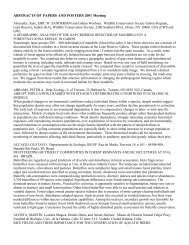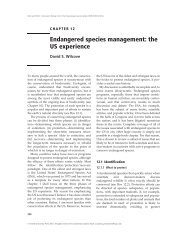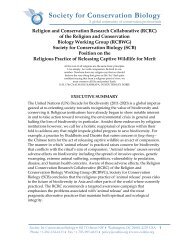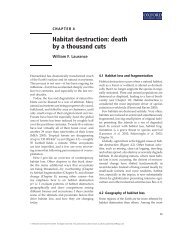ICCB 2013 Program - Society for Conservation Biology
ICCB 2013 Program - Society for Conservation Biology
ICCB 2013 Program - Society for Conservation Biology
You also want an ePaper? Increase the reach of your titles
YUMPU automatically turns print PDFs into web optimized ePapers that Google loves.
• Workshop: Population, Health and Environment: Securing the Mandate and Building the Capacity to<br />
Integrate Health Services into Existing <strong>Conservation</strong> <strong>Program</strong>mes (Day 1 of 2)<br />
July 24, Room 302<br />
July 25, Room 303<br />
Organizer(s): Mohan, V., Blue Ventures, Harris, A., Blue Ventures<br />
• Workshop: Resolving Environmental Conflicts: A Mediator shares Lessons <strong>for</strong> Resource Managers, Scientists<br />
and Stakeholders (Day 2 of 2)<br />
July 23 & July 24, Room 303<br />
Organizer(s): Moore, L., Lucy Moore Associates, Inc.<br />
• Workshop: Assessing the Strengths and Weaknesses of Natural Resource Governance in Landscapes and<br />
Seascapes: a Simple Tool <strong>for</strong> <strong>Conservation</strong> Practitioners<br />
July 24, Room 304<br />
Organizer(s): Wilkie, D., Wildlife <strong>Conservation</strong> <strong>Society</strong>, Russel, D., United States Agency <strong>for</strong> International<br />
Development<br />
• Workshop: ARKive.org: Using Imagery as an Emotive Bridge to <strong>Conservation</strong><br />
July 24, Room 307<br />
Organizer(s): Vitali, L., ARKive (Wildscreen USA)<br />
• Workshop: Enhancing Diversity in the <strong>Conservation</strong> Science Work<strong>for</strong>ce: What are the Barriers to Increasing<br />
Diversity and What can Organizations like SCB do<br />
July 24, Room 308<br />
Organizer(s): Blair, M., Center <strong>for</strong> Biodiversity and <strong>Conservation</strong>, American Museum of Natural History; Sterling,<br />
E., Center <strong>for</strong> Biodiversity and <strong>Conservation</strong>, American Museum of Natural History<br />
• Workshop: Here Today, Gone Tomorrow Implications of paddd <strong>for</strong> <strong>Conservation</strong> Science and Policy<br />
July 24, Room 310<br />
Organizer(s): Krithivasan, R., WWF-US, Mascia, M., WWF-US<br />
Wednesday<br />
Early afternoon awards ceremony and plenary session: 2:00 p.m. to 3:30 p.m.<br />
Grand Ballroom I&II<br />
Wednesday, July 24, 14:00 to 15:30<br />
Awards Ceremony: Edward T. LaRoe III Memorial aWard<br />
The Edward T. LaRoe III Memorial Award recognises the innovative application of science to resource management<br />
and policy by scientists.<br />
The <strong>2013</strong> LaRoe awardee is Robin Waples. Robin has had a creative and productive career, and has had a<br />
tremendous record of applying science to conservation. In his 25-year career with the US government, he led the<br />
ef<strong>for</strong>ts of the National Oceanic and Atmospheric Administration to interpret what Congress meant when they said<br />
that “distinct population segments” (DPSs) could be listed under the Endangered Species Act. The result was his<br />
1991 paper that set the foundation <strong>for</strong> defining criteria <strong>for</strong> DPS status <strong>for</strong> all taxa under the US ESA. No scientist<br />
has had a greater effect on application of the ESA to conservation than Robin.<br />
Plenary Session<br />
Humans as Biological Sensors, Democratization of Science, and Our New Relationship with the Earth<br />
Dr. John Fitzpatrick<br />
Director, Cornell Laboratory of Ornithology and Professor, Ecology and Evolutionary <strong>Biology</strong>, Cornell University<br />
Dr. Caren Cooper<br />
Research Associate, Cornell Laboratory of Ornithology and Senior Fellow, Environmental Leadership <strong>Program</strong><br />
Citizen science has matured from a quirky and experimental novelty into a multi-purpose tool <strong>for</strong> scientific research,<br />
conservation applications, and even social activism. Engaging human observers as distributed sensors and data-loggers<br />
began as early as the mid-1800s, but Internet and mobile technology have revolutionized the process, greatly expanding<br />
our opportunity to map, model, and interpret Earth’s systems at multiple scales and in surprising detail. We provide<br />
several examples, emphasizing new results from the rapidly growing, global bird-checklist project, eBird, perhaps the<br />
137






